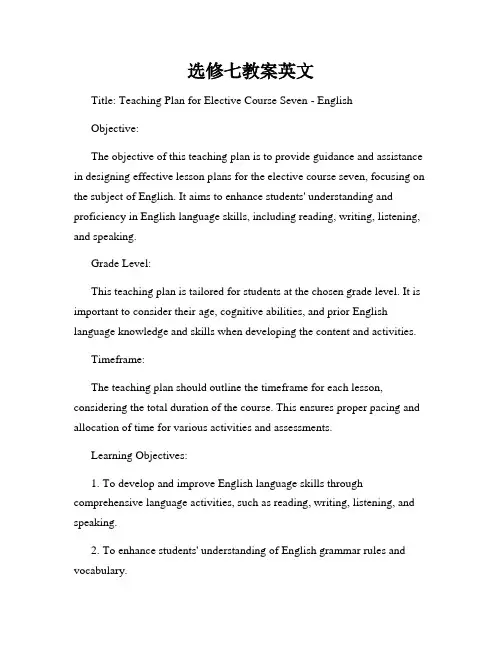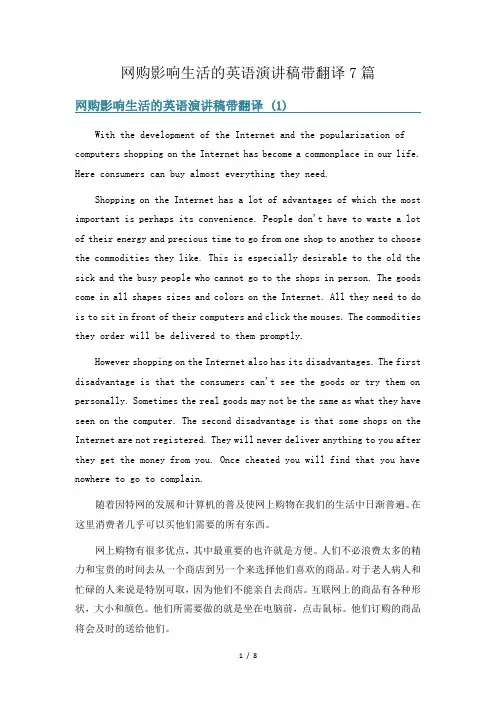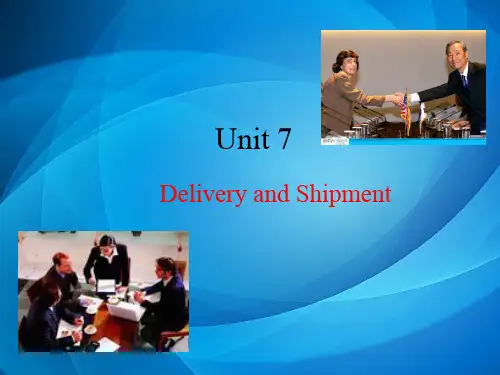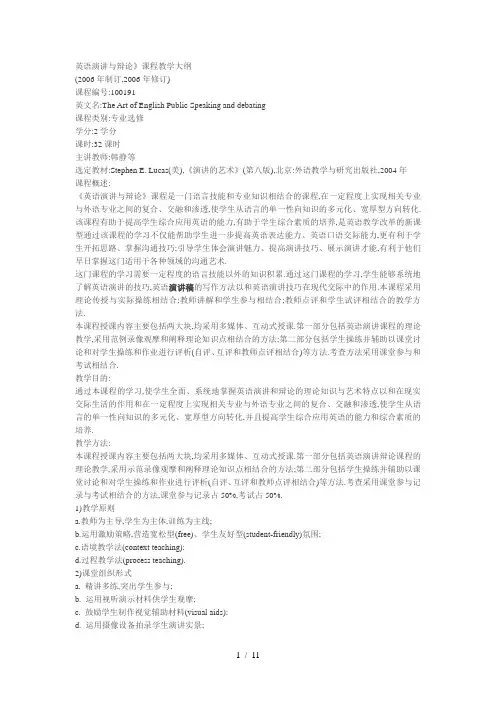英语演讲选修课教案7Methods of delivery
The_art_of_public_speaking[1](1)
](https://uimg.taocdn.com/0844a922ccbff121dd3683ed.webp)
was first developed by the ancient Greeks. were taught first by a group of self-styled "sophists" who were known to "make the weaker argument the stronger." Plato and Aristotle developed theories of public speaking in opposition to the Sophists.
18
Public Speaking
a vital means of communication
a way of making your ideas public – of
sharing them with other people and of influencing other people
41% of the 3000 respondents listed "fear of public speaking" as their No.1 fear, while 19% listed "death."
The top 5 fears of people are : 1. Public speaking!!! 2. Heights. 3. Insects and bugs. 4. Financial problems. 5. Deep water.
• What applied skills and basic knowledge are most important for those you will hire with a four-year college diploma?
选修七教案英文

选修七教案英文Title: Teaching Plan for Elective Course Seven - EnglishObjective:The objective of this teaching plan is to provide guidance and assistance in designing effective lesson plans for the elective course seven, focusing on the subject of English. It aims to enhance students' understanding and proficiency in English language skills, including reading, writing, listening, and speaking.Grade Level:This teaching plan is tailored for students at the chosen grade level. It is important to consider their age, cognitive abilities, and prior English language knowledge and skills when developing the content and activities.Timeframe:The teaching plan should outline the timeframe for each lesson, considering the total duration of the course. This ensures proper pacing and allocation of time for various activities and assessments.Learning Objectives:1. To develop and improve English language skills through comprehensive language activities, such as reading, writing, listening, and speaking.2. To enhance students' understanding of English grammar rules and vocabulary.3. To encourage critical thinking and analytical skills through various exercises and discussions.4. To facilitate cross-cultural understanding and effective communication in English.5. To promote self-learning and independent study habits through individual and group assignments.Teaching Methodology:1. Communicative Approach: Emphasize the use of English as a means of communication, allowing students to actively engage in activities that encourage speaking and listening in English.2. Task-Based Learning: Provide students with real-life tasks and challenges that require the application of English language skills, enabling them to utilize their knowledge in practical situations.3. Cooperative Learning: Encourage students to work collaboratively in pairs or groups, fostering teamwork, peer learning, and communication skills.4. Technology Integration: Utilize digital resources, multimedia tools, and online platforms to enhance engagement and provide interactive learning experiences.Assessment and Evaluation:1. Formative Assessment: Use a variety of formative assessment techniques such as quizzes, group discussions, short assignments, and peer feedback to monitor students' progress and identify areas for improvement.2. Summative Assessment: Administer periodic tests or evaluations to measure and assess students' overall understanding and achievement in the English language.Lesson Plan Components:1. Introduction: Provide an overview of the lesson, including objectives, key concepts, and the relevance of the topic.2. Warm-up activity: Set the stage for learning by engaging students in a short warm-up activity or discussion related to the lesson's theme.3. Presentation: Introduce new vocabulary, grammar rules, or language structures through clear explanations, examples, and visuals.4. Practice activities: Provide opportunities for students to practice the newly learned skills or concepts through interactive exercises, group discussions, role-plays, or games.5. Consolidation and application: Engage students in activities that require them to apply their acquired knowledge and skills in different contexts, promoting deeper understanding and retention.6. Conclusion: Review the main points of the lesson and provide opportunities for students to reflect on their learning progress.7. Homework and independent study: Assign relevant tasks or exercises for students to complete outside the classroom, encouraging self-directed learning and reinforcing concepts taught in class.By following this teaching plan, educators can effectively design and implement lessons for the elective English course, fostering languageproficiency, critical thinking, and cross-cultural understanding among students.。
网购影响生活的英语演讲稿带翻译7篇

网购影响生活的英语演讲稿带翻译7篇网购影响生活的英语演讲稿带翻译 (1) With the development of the Internet and the popularization ofcomputers shopping on the Internet has become a commonplace in our life.Here consumers can buy almost everything they need.Shopping on the Internet has a lot of advantages of which the mostimportant is perhaps its convenience. People don't have to waste a lotof their energy and precious time to go from one shop to another to choosethe commodities they like. This is especially desirable to the old thesick and the busy people who cannot go to the shops in person. The goodscome in all shapes sizes and colors on the Internet. All they need to dois to sit in front of their computers and click the mouses. The commoditiesthey order will be delivered to them promptly.However shopping on the Internet also has its disadvantages. The firstdisadvantage is that the consumers can't see the goods or try them onpersonally. Sometimes the real goods may not be the same as what they haveseen on the computer. The second disadvantage is that some shops on theInternet are not registered. They will never deliver anything to you afterthey get the money from you. Once cheated you will find that you havenowhere to go to complain.随着因特网的发展和计算机的普及使网上购物在我们的生活中日渐普遍。
国际商务谈判 Unit 07 Delivery and Shipment

货柜,集装箱 船只 租船方 班轮 直达轮 不定期船 运费表 收货人 使集装箱化
Useful Words and Phrases
deliver v. 发货 deliver sth.to sb.
delivery n. 发货
转船
ship v. 装船,装运
Introduction
For the sellers,setting a proper time of shipment is the first important thing in delivery negotiation.In deciding the time for shipment,the sellers should be cautious because they might face a claim if they fail to deliver the goods at the agreed time.Careful consideration should be given to the following:
1.Supply of the goods. 2.Transportation. 3.Condition of the goods.
Introduction
The buyers often require shipment as soon as possible, and the earlier,the better.Hence,speeding up delivery is what the buyers care most about.But how can we shorten the time of delivery and help the buyers place the goods on the market at the earliest time? Usually you can:
英语演讲与辩论课程教学大纲

英语演讲与辩论》课程教学大纲(2006年制订,2006年修订)课程编号:100191英文名:The Art of English Public Speaking and debating课程类别:专业选修学分:2学分课时:32课时主讲教师:韩静等选定教材:Stephen E. Lucas(美),《演讲的艺术》(第八版),北京:外语教学与研究出版社,2004年课程概述:《英语演讲与辩论》课程是一门语言技能和专业知识相结合的课程,在一定程度上实现相关专业与外语专业之间的复合、交融和渗透,使学生从语言的单一性向知识的多元化、宽厚型方向转化.该课程有助于提高学生综合应用英语的能力,有助于学生综合素质的培养,是英语教学改革的新课型通过该课程的学习不仅能帮助学生进一步提高英语表达能力、英语口语交际能力,更有利于学生开拓思路、掌握沟通技巧;引导学生体会演讲魅力、提高演讲技巧、展示演讲才能,有利于他们早日掌握这门适用于各种领域的沟通艺术.这门课程的学习需要一定程度的语言技能以外的知识积累.通过这门课程的学习,学生能够系统地了解英语演讲的技巧,英语演讲稿的写作方法以和英语演讲技巧在现代交际中的作用.本课程采用理论传授与实际操练相结合;教师讲解和学生参与相结合;教师点评和学生试评相结合的教学方法.本课程授课内容主要包括两大块,均采用多媒体、互动式授课.第一部分包括英语演讲课程的理论教学,采用范例录像观摩和阐释理论知识点相结合的方法;第二部分包括学生操练并辅助以课堂讨论和对学生操练和作业进行评析(自评、互评和教师点评相结合)等方法.考查方法采用课堂参与和考试相结合.教学目的:通过本课程的学习,使学生全面、系统地掌握英语演讲和辩论的理论知识与艺术特点以和在现实交际生活的作用和在一定程度上实现相关专业与外语专业之间的复合、交融和渗透,使学生从语言的单一性向知识的多元化、宽厚型方向转化,并且提高学生综合应用英语的能力和综合素质的培养.教学方法:本课程授课内容主要包括两大块,均采用多媒体、互动式授课.第一部分包括英语演讲辩论课程的理论教学,采用示范录像观摩和阐释理论知识点相结合的方法;第二部分包括学生操练并辅助以课堂讨论和对学生操练和作业进行评析(自评、互评和教师点评相结合)等方法.考查采用课堂参与记录与考试相结合的方法,课堂参与记录占50%,考试占50%.1)教学原则a.教师为主导,学生为主体,训练为主线;b.运用激励策略,营造宽松型(free)、学生友好型(student-friendly)氛围;c.语境教学法(context teaching);d.过程教学法(process teaching).2)课堂组织形式a. 精讲多练,突出学生参与;b. 运用视听演示材料供学生观摩;c. 鼓励学生制作视觉辅助材料(visual aids);d. 运用摄像设备拍录学生演讲实景;e. 先讲后评,组织讨论;f. 运用评估表(evaluation sheet)分析学生演讲;g.大班与小班授课应有区别.各章教学要求和教学要点第一章Speaking And Listening教学要求:本章教学要求学生比较全面了解演讲的基本理论和概念,演讲中的道德准则以和倾听在言语交流中的重要性.教学内容:一、Speaking in Public1. The Power of Public Speaking2. The Tradition of Public Speaking3. Similarities Between Public Speaking and Conversation4. Differences Between Public Speaking and Conversation5. Developing Confidence: Your Speech Class6. Public Speaking and Critical Thinking7. The Speech Communication Process8. Public speaking in a Multicultural World二、Ethics and Public Speaking1. The Importance of Ethics2. Guidelines for Ethical Speaking3. Plagiarism4. Guidelines for Ethical Listening三、Listening1. Listening Is Important2. Listening and Critical Thinking3. Four Causes of Poor Listening4. How to Become a Better Listener思考题:1. In what way is public speaking likely to make a difference inyour life?2. How is public speaking different from everyday conversation?3. How can you control your nervousness and make it work for you in your speeches?4. What are the seven elements of the speech communication process? How do they interact to determine the success or failure of a speech?第二章Speech Preparation: Getting Started教学要求:本章教学要求学生了解在演讲的准备阶段如何选题和立意,如何分析听众的特点,如何收集资料和如何规范地使用所搜集到的论据来说明自己的想法.教学内容:Selecting a Topic and Purpose1. Choosing a Topic2. Determining the General Purpose3. Determining the Specific Purpose4. Phrasing the Central Idea二、Analyzing the Audience1. Audience-Centeredness2. Your Classmates as an Audience3. The Psychology of Audiences4. Demographic Audience Analysis5. Situational Audience Analysis6. Getting Information About the Audience7. Adapting to the Audience三、Gathering Materials1. Using Your Own Knowledge and Experience2. Doing Library Research3. Searching the Internet4. Interviewing5. Tips for Doing Research四、Supporting Your Ideas1. Supporting Materials and Critical Thinking2. Examples3. Statistics4. Testimony5. Sample Speech with Commentary思考题:1. What is the difference between the specific purpose and the central idea of a speech? What are four guidelines for an effective central idea?2. What methods can you use to adapt your speech to your audience before the speech? During the speech?3. What five things should you do to take research notes efficiently?4. What are five tips for using examples in your speeches?第三章Speech Preparation: Organizing and Outlining教学要求:本章教学要求学生系统掌握英语演讲稿的写作方法和写作规范.教学内容:Organizing the Body of the Speech1. Organization Is Important2. Main Points3. Supporting Materials4. Connectives二、Beginning and Ending the Speech1. The Introduction2. The Conclusion三、Outlining the Speech1. The Preparation Outline2. The Speaking Outline思考题:1. What are the five basic patterns of organizing main points in a speech? Which are appropriate for informative speeches? Which is used only in persuasive speeches? Which is used most often?2. What are seven methods you can use in the introduction to getthe attention and interest of your audience?3. What are four ways to reinforce the central idea when concluding your speech?4. What is a preparation outline? What are the eight guidelines discussed in the chapter for writing a preparation outline?5. What is a speaking outline? What are four guidelines for your speaking outline?第四章Presenting The Speech教学要求:本章教学要求学生基本掌握演讲写作中的语言技巧,演讲的不同形式,以和直观教具的制作和用法.教学内容:一、Using Language1. Language Is Important2. Meanings of Words3. Using Language Accurately4. Using Language Clearly5. Using Language Vividly6. A Note on Inclusive Language二、Delivery1. What is a Good Delivery?2. Methods of Delivery3. The Speaker's Voice4. The Speaker's Body5. Practicing Delivery6. Answering Audience Questions三、Using Visual Aids1. Advantages of Visual Aids2. Kinds of Visual Aids3. Guidelines for Preparing Visual Aids4. Guidelines for Presenting Visual Aids思考题:1. What are three things you should do to use language clearly in your speeches?2. Why is it important for a public speaker to use inclusive language? What are five usages of inclusive language which have become so widely accepted that no speaker can afford to ignore them?3. What are the eight aspects of voice usage you should concentrate on in your speeches?4. What are the five steps you should follow when practicing your speech delivery?5. What steps should you take when preparing for a question-and-answer session? What should you concentrate onwhen responding to questions during the session?6. What are the major advantages of using visual aids in your speeches?第五章Varieties of Public Speaking教学要求:本章教学要求学生掌握演讲的几种主要的体裁,能够在不同的场合选择不同的方式进行有效演讲.教学内容:教学内容:Speaking to Inform1. Types of Informative Speeches: Analysis and Organization2. Guidelines for Informative Speaking3. Sample Speech with Commentary4. The Importance of Persuasion5. Persuasive Speeches on Questions of Fact6. Persuasive Speeches on Questions of Value7. Persuasive Speeches on Questions of Policy二、Methods of Persuasion1. Building Credibility2. Using Evidence3. Reasoning4. Appealing to emotions三、Speaking on Special Occasions1. Speeches of Introduction2. Speeches of Presentation3. Speeches of Acceptance4. Commemorative Speeches5. After-Dinner Speeches四、Speaking in Small Groups1. What Is a Small Group?2. Leadership in Small Groups3. responsibilities in a Small Group4. The Reflective-Thinking Method5. Presenting the Recommendations of the Groups思考题:1. Why must informative speakers be careful not to overestimate what the audience knows about the topic? What can you do to make sure your ideas don't pass over the heads of your listeners?2. What are three methods you can use to avoid abstractions in your informative speech?3. Explain the difference between passive agreement and immediate action as goals for persuasive speeches on questions of policy.4. What four methods of organization are used most often inpersuasive speeches on questions of policy?5. What are four tips for using evidence effectively in a persuasive speech?6. What are the three major traits of a good acceptance speech?7. What are the five major responsibilities of every participant in a small group?参考书目:1)Lucas, Stephen E. The Art of Public Speaking. 8th Ed. New York: McGraw Hill, 2004. 配有Instructor's Manual.2)Verderber, Rudolph F. The Challenge of Effective Speaking. 10th Ed. Boston: Wadsworth Publishing Company, 1997.3) Collins, Patrick. Say It with Power & Confidence. Paramus: Prentice Hall, 1998.4)Kay, Sue(英):《实用演讲技巧》,北京:外语教学与研究出版社,2004.5)亚历山大(Alexander, L. G.)(英),《英语辩论手册》,北京:外语教学与研究出版社,1999.6)纪玉华、陈向军、Andrew N. Brown,《英语演讲与辩论教程》,厦门:厦门大学出版社,2004.7)王守仁,何宁,《新编英语口语教程》,上海:上海外语教育出版社,1998.8)杨俊峰(编译),《实用演讲技能教程》,沈阳:辽宁教育出版社,2001.9)谢伯端,《实用演讲与口才教程》,武汉:华中理工大学出版社,1996.10)黄士基,《演说的技巧与艺术》,武汉:华中理工大学出版社,1991.执笔人: 韩静2006年5月审定人: 黄能2006年5月系负责人: 王克明2006年7月11 / 11。
商务英语综合教程Unit 7 Methods of Payment for Imports and Exports

Text
Unit 7 Payments for imports and exports
12 It should be noted that the drawing of a bill of exchange on
the buyer does not guarantee payment and the seller has lost control of the goods to some extent as they are out of his country. Moreover, he may have to arrange for storage and insurance or even re-shipment. Under such circumstances, there arises “international factoring”. When making payment by collection, open account, etc. an arrangement is made between a supplier, especially an exporter of textiles, and a special kind of finance house called a factor or factoring company, by which the supplies sells to the factor the right to collect amounts payable to the supplier by approved customers at some future date. Thus the supplier receives payment immediately he supplies the goods, the factor’s taking full responsibility for collecting the accounts and bearing all losses from bad debts. The factor’s charges consist of a fee based on the rate of discount for bills of exchange and an added small percentage for collecting the accounts. In Britain, factoring companies are owned by commercial banks, merchant banks and some export houses.
DELIVERY演讲
LCCC ENG 111
KimAlyse Popkave, M.Ed., CMI, CPPC Instructor
18
DELIVERY
APPEARANCE
Listeners Always See A Speaker
Before They Hear The Speaker. Dress & Groom Appropriately
(Quote Logue, 121)
KimAlyse Popkave, M.Ed., CMI, CPPC Instructor
2
DELIVERY
Four Methods of
Delivery
LCCC ENG 111
KimAlyse Popkave, M.Ed., CMI, CPPC Instructor
8
DELIVERY
VOICE: VOLUME Adjust Volume To Acoustics Of The Room & Size Of Audience
LCCC ENG 111
KimAlyse Popkave, M.Ed., CMI, CPPC Instructor
9
DELIVERY
To Feedback
LCCC ENG 111
KimAlyse Popkave, M.Ed., CMI, CPPC Instructor
24
DELIVERY
Five Steps To Improving
Delivery
LCCC ENG 111
KimAlyse Popkave, M.Ed., CMI, CPPC Instructor
Can ConcYour Audience Used In Only Brief Speeches
Unit7ShipmentandDelivery
Unit7ShipmentandDeliveryUnit 7 Shipment and DeliveryFirst of all, any body can tell me what differences there are between shipment and delivery?Focus:1.Get the main idea of shipment and delivery2.Practice the conversation about shipment3.Master the key words and useful expressions about shipment and delivery4.Practice the business letters about shipment and deliveryOutline:Period 1-2: introduction about shipment and deliveryto practice dialogues on shipmentPeriod 3-4: to study samples letters about shipment and deliveryPeriod 5-6: exercises and practiceTeaching methods:Instruction, oral English practice, explanation of key points and sentences, discussionPeriod 1-2Step 1 (50mins)T introduces the following basic knowledge about shipment and delivery1. Importance of ShipmentTo urge an early shipment;To amend shipping terms;To give shipping advice;To dispatch shipping documents.What’s the relationship between the date of shipment andthe date of delivery?2. The necessary procedures of shipment3. Major terms of shipment4. Major shipping documents-B/LStep 2(10mins)Ask Ss to read the related words and expressions, then T explain some difficult words and expressions to SsStep 3(10mins)Ask Ss to read brief introduction on page 78, then T ask Ss some questionsStep 4 (20 mins)T explains some important points of the dialogues for Ss. Main points are as follows:Dialogue one1.effect shipment 装运2.red tape 繁琐的手续3.lose out 输掉,失败Dialogue two1.out of the question 不可能,不值得考虑2.out of question 毫无疑问,毫无问题3.transshipped转船的4.sailings船次Pair work: Ss are required to work with their partners to try to fill in the blanks.Next, T will ask one or two pairs to read out the dialogues with their answers.Ask Ss demonstrate those dialogues by role playPeriod 3-4Sample letter 1-Asking for Effecting Shipment (20 mins)T asks Ss to read sample letters 1 on page 82T explains to Ss the reasons and purpose for writing this letter, and makes Ss understand the main idea of this letter. Pay attention to the difference between Delivery and Shipment.Sample letter 2-A Reply to an Enquiry about Transshipment (15 mins)T asks Ss to read sample letters 2 on page 83T explains what types of letter it is. Pay attention to the characteristics of reply letters. Focus on the usage of following words & phrasesTransshipment, sailing, shipping space, Through Bill of LoadingSample letter 3- A Reply to an Enquiry about Container (20 mins)This letter is a reply to an enquiry about containerFocus on the knowledge of container, such as the size of the container, the types of container, and the methods of consignment (refer to PPT)Sample letter 4-A Discussion on Shipment (20 mins)T explains the main points of this shipment letter, differentiate “shipping advice”and “shipping instruction”, and stresses the following important expressions:We have acknowledgement your letter…我们确认收到你方来信……Upon receipt of 一收到……Without the least delay 尽量不耽误Please try your best to ship by that steamer尽量用那艘船装运Should this trial order prove satisfactory to our customers=If this trial order prove satisfactory to our customersassure使某人确信,向某人保证assure sb. of sth.assure sb. thatrest/be assured thatrest/be assured of sth.Sample letter 5-A Shipment Announcement (15mins)It is a shipment announcement, and T focuses on the reasons of packing in cartonPeriod 5-6Step 1 (30mins)Ss work in pair or group, and try to translate the useful expressions on page 87-88 into Chinese. This is supposed to help Ss be familiar with the regular expressions in both Chinese and English. Next, T asks Ss to read and translate each sentence into Chinese one by oneStep 2(20mins)Exercise 1. Ss work in pair or group and compose a dialogue according to the given situation.(refer to page 88)T asks two pairs to demonstrate their dialogues.Step 3 (20mins)Exercise 2. T require Ss to translate the following into English Exercise 3.T require Ss to translate the following sentences into ChineseStep 4 (20mins)Writing- to practice how to write a letter of shipment and delivery.Ss work in pair or group, and try to translate the letter in Chinese according to the following requirement1.Write a letter to complain damaged shipment.2.Write a letter to apologize the delay of shipment.T may give a Chinese letter to Ss as extra work and ask themto translate it into English.Extra HomeworkWriting:As secretary of Harding & Co. of Hull, write to Scandinavian Liners Ltd. for details of their sailings to Norway and Sweden and for quotations of their rates for manufactured woolen goods. 教学后记:培养学生兴趣与信心,师生间的情感交流是学生学好外贸英语函电首要因素,本课采用了引导式互动方式取得了较好的效果。
演讲的艺术chapter11delivery
McGraw-Hill
© 2007 Stephen E. Lucas. All rights reserved.
Slide 10
Practicing Delivery
• 1. do through the preparation outline and revise it.
• 2. speaking outline • 3. practice the speech aloud • 4. polish and refine your delivery • 5. a dress rehearsal
a speech
Effectively pause between every though pattern
McGraw-Hill
© 2007 Stephen E. Lucas. All rights reserved.
Slide 8
The Speaker’s Voice
• Volume • Pitch • Rate • Pauses
McGraw-Hill
© 2007 Stephen E. Lucas. All rights reserved.
Slide 5
The sparker's Voice
• Pitch the highness and lowness of a
speakers’ voice vary your pitch pattern to fit the meaning of your words.
Slide 1
演讲的艺术chapter1Fra bibliotekdelivery
McGraw-Hill
本课件仅供大家学习学习 学习完毕请自觉删除
谢谢 本课件仅供大家学习学习
英语演讲的艺术two
Pitch 音高
• Pitch: the highness or lowness of a speaker’s voice. • Changes in pitch are called inflections. • They give voice luster, warmth, and vitality. • They reveal whether you ask a question or make a statement, whether you are sincere or sarcastic.
Pauses 停顿
• Pause: a momentary break in the vocal delivery of a speech. • Learning how and when to pause is a major challenge for most speakers. • A keen sense of timing is partly a matter of common sense, partly a matter of experience. • Pause at the end of thought units and not in the middle.
• They make you sound happy or sad, angry or pleased, dynamic or listless, tense or relaxed. • Avoid ending all your sentences on the same inflection. Otherwise, it’s monotony. • Vary your pitch patterns to fit the meaning of your words.
- 1、下载文档前请自行甄别文档内容的完整性,平台不提供额外的编辑、内容补充、找答案等附加服务。
- 2、"仅部分预览"的文档,不可在线预览部分如存在完整性等问题,可反馈申请退款(可完整预览的文档不适用该条件!)。
- 3、如文档侵犯您的权益,请联系客服反馈,我们会尽快为您处理(人工客服工作时间:9:00-18:30)。
Chapter 7Methods of deliveryFour basic methods of delivering a speech1.Reading from a manuscript: A speech that is written out word for word and read to theaudience.2.Reciting from memory3.Speaking impromptu: a speech delivered with little or no immediate preparation.4.Speaking extemporaneously: A carefully prepared and rehearsed speech that ispresented from a brief set of notes.The speaker’s voice1.volume : the loudness or softness of the speaker’s voice.Too loud, your listeners will think you boorishToo soft, your listeners will not understand you.To be heard clearly is the principle.2.Pitch: t he highness or lowness of the speaker’s voice.Monotone: a constant pitch or tone of voice, (no variation in pitch) should be avoid.3.Rate: the speed at which a person speaks.There is no uniform rate for effective speechmaking.Martin Luther King spoke at roughly 90 words per minute; Franklin Roosevelt spoke at 110 words per minute, John Kennedy at 180,A fast rate helps crate feelings of happiness, fear, anger, and surprise, while aslow rate is better for expressing sadness or disgust.Two obvious faults to avoid are speaking so slowly that your listeners become bored or so quickly that they lose track of your ideas.4.Pauses: A momentary break in the vocal delivery of a speech.Learning how and when to pause is a major challenge for most beginning speakers. Even a moment of silence can seem like an eternity. As you gain more poise and confidence, you will discover how useful the pause can be. It can signal the end of a thought unit, give an idea time to sink in, and lend dramatic impact to a statement.When you do pause, make sure you pause at the end of a thought unit and not in the middle.Otherwise, you may distract listeners from your ideas. Most important, do not fill the silence with vocalized pauses like “uh”, “er”, or “um”.Mark Twain: The right word may be effective, but no word was ever as effective as a rightly timed pause.5.vocal variety: changes in a speaker’s rate, pitch, and volume that give the voice variety andexpressiveness.Just as variety is the spice of life, so is it the spice of public speaking. A flat, listless, unchanging voice is just as deadly to speechmaking as a flat, listless, unchanging routine is to daily life.Diagnose your voice to decide which aspects need improvement. Record your speeches to hear how they sound. Try them out on your friends. And make adjustments.If you want to learn more, surf /handouts/esl/eslstudent.html6.Pronunciation7.articulation: the physical production of particular speech sounds.Word Misarticulationought to ottadidn’t dintfor furwant to wannaThe speaker’s bodyPosture, facial expression, gestures, eye contact------all effect the way listeners respond to a speaker. Here are the major aspects of physical action that will affect the outcome of your speeches.Personal appearance : A number of studies have confirmed that personal appearance plays an important role in speechmaking. Listeners always see you before they hear you, so you should dress and groom appropriately. You should try to evoke a favorable first impression—an impression that is likely to make listeners more receptive to what you say.Movement:As you rise to speak, try to appear calm, poised, and confident, despite the butterflies in your stomach. When you reach the lectern, don’t lean on it, and don’t rush into your speech. Give yourself time to get set. Arrange your notes just the way you want them. Stand quietly as you wait to make sure the audience is paying attention. Establish eye contact with your listeners. Then---and only then---should you start to talk.When you reach the end of your speech, maintain eye contact for a few moments after you stop talking. This will give your closing line time to sink in.All this advice is common sense, yet you would be surprised how many people need it. When practicing your speeches, spend a little time rehearsing how you will behave at the beginning and at the end. It is one of the easiest—and one of the most effective----things you can do to improve your image with an audience.GesturesThe rule is: whatever gestures you make should not draw attention to themselves and distract from your massage. They should appear natural and spontaneous, help clarify or reinforce your ideas, and be suited to the audience and occasion.Eye contact (direct visual contact with the eyes of another person) One of the quickest ways to establish a communicative bond with your listeners is to look at them personally and pleasantly. Avoiding their gaze is one of the surest ways to lose them. There is a great deal of research to show that speakers in the United States who refuse to establish eye contact are perceived as tentative or ill at ease and may be seen as insincere or dishonest.As you look at your listeners, be alert for their reactions: Can they hear you? Do they understand you? Are they awake? Your eyes will help you answer these questions.It is not enough just to look at your listeners: how you look at them also counts. A blank stare is almost as bad as no eye contact at all. So is a fierce, hostile glower or a series of frightened, bewildered glances.SummarySpeech delivery is a matter of nonverbal communication. It is based on how you use your voice and body to convey the message expressed by your words. You cannot make a good speech without having something to say, but you also need to know how to say it. Rather than calling attention to itself, effective delivery conveys the speaker’s ideas clearly, engagingly, and without distracting the audience.There are four basic methods of delivering a speech:To use your voice effectively you should work on controlling your volume, pitch, rate, pauses, vocal variety, pronunciation, articulation.Posture, personal appearance, facial expression, gestures, and eye contact also affect the way listeners respond to speakers.。
